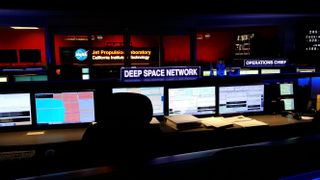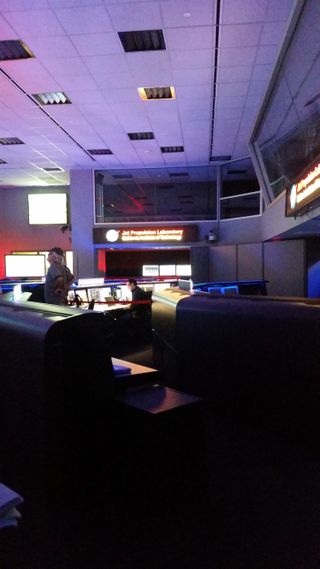Inside NASA's Jet Propulsion Laboratory: Our Look at the 'Center of the Universe'

When NASA's Mars Science Laboratory screamed through the Red Planet's atmosphere in a daring feat scientists later dubbed "7 minutes of terror," viewers around the world tuned in to watch.
No one could see the spacecraft during those tense moments; instead, the world studied the men and women in charge of the landing: the engineers at NASA's Jet Propulsion Laboratory. Far from stodgy, white-coated scientists, the personnel at the California-based facility boasted mohawks and piercings, along with their enthusiasm, at the successful landing, and unintentionally promoted the idea that rocket geeks can be cool.
Founded in the mid-1930s, the Jet Propulsion Laboratory (JPL) is nestled in California's San Gabriel Mountains. After several students at the nearby California Institute of Technology were involved in an accidental explosion on the campus, the school strongly suggested they search for a more isolated area to pursue their rocket-building experiments, according to the JPL history website. [Mars Rover Curiosity's 7 Biggest Discoveries (So Far)]
In the 1940s, the lab worked to develop rocket technology under the umbrella of the U.S. Army, and it kept its name as a nod to its origin when it joined the newly formed National Aeronautics and Space Administration (NASA) at the end of the 1950s. Today, the lab develops many of the scientific payloads for NASA missions.
High security
JPL is located outside Los Angeles, in Pasadena. I gave my name to the guards at the campus entrance before pulling into the visitor parking lot. Another guard booth near the welcome center meant I couldn't take my own tour. (I had come as part of a press group, but JPL provides educational and public group tours as well.)
The institution is highly secure, and requires vetting before the tour. Our press group was met by Jia-Rui Cook and Mark Petrovich, two of JPL's media-relations folks. After everyone checked in, we walked through another checkpoint and boarded a bus to drive us around the expansive facility.
Building a spacecraft
Our first stop was the spacecraft assembly facility, where we were greeted by Ken Farley, project scientist for Mars 2020. Through a glass panel, we looked into an enormous three-story room filled with various equipment. Oblivious to the observers, a handful of individuals dressed in clean room suits worked earnestly at various stations, their faces, hands and feet all covered.
Get the Space.com Newsletter
Breaking space news, the latest updates on rocket launches, skywatching events and more!

According to Cook and Petrovich, the scientists were working on multiple projects, but the only one they could definitively identify was the heat shield for Mars 2020, a giant disc covered with a protective silver blanket. The shield, a nearby table and several crates were all cordoned off, and signs read "Flight Hardware, Do Not Touch."
Next to the heat-shield hardware stood "Cleanroom Bob," a dummy covered in a clean room suit that fooled me into thinking he was real, until I realized he hadn't moved throughout the presentation. He serves as a model for tours when no one is working in the clean room, demonstrating how carefully the scientists and engineers must dress for their work assignments.
"Pokémon Go" meets space
Next, we visited the Earth Science Center. When most people think of NASA, they usually recall the agency's role in studying other planets in the solar system. But about a tenth of NASA's budget is spent studying our own pale blue dot. Jason Craig, who works on visualization at JPL, had several interesting computer applications about the Earth to show us.
First up was Eyes on the Earth, a downloadable program that reveals information about the planet, including sea level height, atmospheric carbon dioxide concentration, and ozone levels. The program provides a real-time glimpse of multiple NASA missions. The app also allows users to track any of the satellites observing Earth, including the smallest "cube satellites," which can be as small as 10 cubic centimeters (0.6 cubic inches). Using the app, Craig took us on a tour of Earth.
A second program, called Eyes on the Solar System, allows users to check out missions around other worlds. With the app, users can check out new missions, such as OSIRIS-REx, or older ones, like Voyager 1 and 2.
Both Eyes programs can only be downloaded on a computer, but the next app Craig showed us was made for smartphones. Known as Spacecraft 3D, the app works a lot like "Pokémon Go," though Craig was quick to point out that they were doing it long before people started using their phones to hunt for Pikachu. Instead of encouraging people to search for Japanese cartoon characters, Spacecraft 3D allows users take pictures with their favorite spacecraft by inserting a digital representation of the spacecraft into the phone's camera app. The app requires an augmented-reality target card that can be printed out from the JPL apps website.
My 15-year-old daughter and I had picked up a card from Craig the day before, at a conference we were attending. She spent an hour taking pictures in which the Curiosity rover appeared to be sitting around the hotel room and on her shoulder.
The programs, along with several others, are available on JPL's apps website.
The center of the universe
Our last stop on the tour was the Space Flight Operations Facility, home of the mission control center. Inside the lobby stood a monument to the famed "lucky peanuts," which have made their appearance at important junctures for JPL missions. In 1964, six robotic NASA missions had failed to reach the moon. For the seventh, Ranger 7, mission trajectory engineer Dick Wallace handed out peanuts to the people in mission control, to take off the edge, starting a new JPL tradition.
Our group passed through a set of security doors into the Charles Elachi mission control center. In a room to the left sat two rows of computer panels labeled based on their roles, such as "navigation" and "flight director." Next to each monitor sat a headset, ready to go. In the back corner, holding his own lucky peanuts, stood the Mars Science Laboratory "Mohawk Guy," Bobak Ferdowsi, in a cardboard cutout. Ferdowsi became a minor celebrity when his dramatic haircut drew the public's attention during the landing of the Mars Curiosity rover.
Jim McClure, manager of mission control, welcomed us inside and gave us an overview of the control room and the role it plays in JPL's missions. Then, we watched a video of the infamous "7 minutes of terror" — when Curiosity was hurtling toward the Martian surface and no one knew if it would survive the fall.
Through a set of glass windows, we saw the Deep Space Network command center. Data from all over the solar system streams into telescopes in California, Australia and Spain, and it's all managed in this little room in Pasadena.

The room itself is fairly dark, lit primarily by the glow of multiple banks of computers and several large screens overhead. It is overseen by at least five engineers, seven days a week.
According to McClure, four years ago, former JPL Director Charles Elachi was describing how the control center collects information from both inside and outside the solar system. "This must be the center of the universe!" Elachi reportedly said.
Now, a plaque on the floor of the room makes that title official. In a sunken glass box in the floor sits a seal. "JPL" is written boldly in the middle, encircled by the words "NASA" and "the California Institute of Technology." An "X" divides the seal into four wedges, with an image commemorating the various types of missions (telescopes, landers, orbiters and flybys) in each one. The words beneath the seal proclaim the spot to be "The Center of the Universe."
"We fly our nerd flags extremely high here at JPL — so high we have had four marriage proposals at the center of the universe," McClure said.

Fear of the infamous Los Angeles traffic motivates me to leave the tour early to make sure I don't miss my flight. But the high level of security meant I can't go back to my car alone. While Cook continues with the group, Petrovich escorts my daughter and me to the bus, where we ride back to the visitor parking. I convince him to stop above the famous Mars yard, where rovers are tested under Mars-like conditions, and I take a few pictures. Next time, I promise myself, I'll come back to this yard, and take a walk on Earth's Mars.
Follow Nola Taylor Redd on Twitter @NolaTRedd Facebook or Google+. Follow us at @Spacedotcom, Facebook or Google+. Originally published on Space.com.
Join our Space Forums to keep talking space on the latest missions, night sky and more! And if you have a news tip, correction or comment, let us know at: community@space.com.

Nola Taylor Tillman is a contributing writer for Space.com. She loves all things space and astronomy-related, and enjoys the opportunity to learn more. She has a Bachelor’s degree in English and Astrophysics from Agnes Scott college and served as an intern at Sky & Telescope magazine. In her free time, she homeschools her four children. Follow her on Twitter at @NolaTRedd
Most Popular

